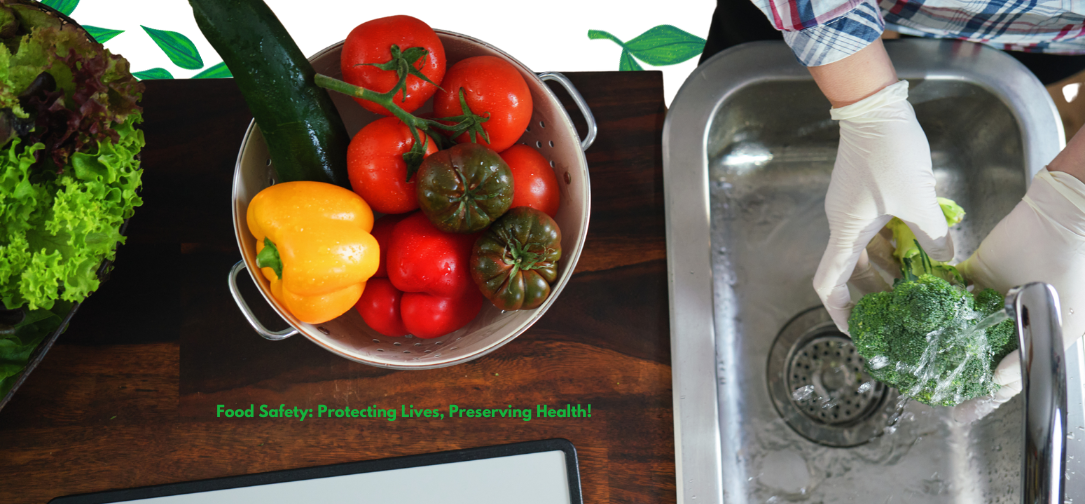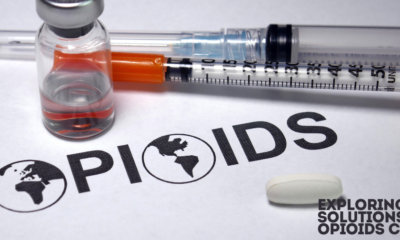Public Health
Food Safety: Avoiding Foodborne Illnesses in Your Home

Food safety is a critical concern worldwide, especially at home, where improper handling and preparation of food can lead to foodborne illnesses. The Centers for Disease Control and Prevention (CDC) estimates that foodborne illnesses affect approximately 48 million people in the United States annually, resulting in 128,000 hospitalizations and 3,000 deaths. Effective food safety practices are essential to avoid these illnesses and ensure that food is safe for consumption. This report explores various aspects of food safety, focusing on common causes of foodborne illnesses, preventive measures, and key guidelines for keeping food safe at home.
Common Causes of Foodborne Illnesses
Foodborne illnesses are often caused by bacteria, viruses, parasites, or toxins that contaminate food at various points, from production to consumption. Some of the most common pathogens include Salmonella, E. coli, Listeria, Norovirus, and Campylobacter. Each of these pathogens can lead to severe gastrointestinal distress and other complications, particularly in vulnerable populations such as infants, pregnant women, older adults, and individuals with weakened immune systems.
For example, Salmonella is typically found in poultry, eggs, and dairy products but can also contaminate fruits, vegetables, nuts, and spices. Symptoms usually manifest within 6 hours to 6 days after exposure. E. coli, another common bacterium, is often linked to undercooked beef, unpasteurized milk or juice, and contaminated fresh produce, with symptoms appearing between 1 to 10 days after consumption. In contrast, Norovirus, the leading cause of foodborne illness outbreaks in the U.S., can be transmitted through contaminated food, water, and surfaces, causing acute gastroenteritis characterized by vomiting and diarrhea. Foods frequently associated with norovirus outbreaks include shellfish, fresh produce, and ready-to-eat foods handled by infected food workers (CDC, 2024).
Key Steps to Ensure Food Safety at Home
To prevent foodborne illnesses, the CDC and other health organizations recommend the following four fundamental steps: Clean, Separate, Cook, and Chill. Adhering to these guidelines can significantly reduce the risk of contamination and illness.
- Clean: Proper cleaning is essential to avoid the spread of bacteria and other pathogens. This includes washing hands with soap and water for at least 20 seconds before and after handling food, especially raw meat, poultry, seafood, or eggs. Additionally, clean cutting boards, utensils, and countertops after preparing each food item. The CDC emphasizes that washing fruits and vegetables is important, but meat and poultry should not be washed, as they can spread harmful bacteria around the kitchen.
- Separate: Cross-contamination occurs when bacteria from one food item, such as raw meat, transfer to other foods. To prevent this, it is crucial to use separate cutting boards and utensils for raw meat and ready-to-eat foods like salads. Storing raw meat, poultry, and seafood in sealed containers or plastic bags on the bottom shelf of the refrigerator can prevent juices from dripping onto other foods.
- Cook: Cooking food to the right temperature is essential to kill harmful bacteria. The CDC provides specific temperature guidelines for different types of food: poultry should be cooked to at least 165°F, ground meats like beef and pork to 160°F, and whole cuts of beef, veal, lamb, and pork to 145°F, followed by a three-minute rest time. Using a food thermometer is the only reliable way to ensure food reaches the correct internal temperature, as color and texture can be misleading indicators of doneness.
- Chill: Keeping perishable foods at the correct temperature is crucial to slow bacterial growth. Refrigerators should be set at or below 40°F, and freezers at 0°F or below. Perishable food should not be left out at room temperature for more than two hours (or one hour if the temperature is above 90°F). To ensure proper chilling, it is advised to store leftovers in shallow containers, which cool food more quickly, and to thaw frozen foods in the refrigerator, cold water, or a microwave rather than on the counter.
Specific Food Safety Considerations
Certain foods require extra care due to their susceptibility to contamination:
- Eggs and Poultry: These are often associated with Salmonella. Cooking eggs until both the yolk and white are firm and ensuring that poultry is cooked to 165°F can help prevent illness.
- Seafood: Raw or undercooked seafood, especially shellfish like oysters, can carry Vibrio and Norovirus. To mitigate risks, cook seafood to the appropriate temperature and source shellfish from reputable suppliers.
- Fresh Produce: Even fruits and vegetables can harbor pathogens like E. coli and Listeria. Washing produce under running water and using a brush for items with thicker skins can reduce contamination risks.
- Processed and Ready-to-Eat Foods: Foods like deli meats, hot dogs, and refrigerated smoked seafood are prone to contamination with Listeria, which can continue to grow even in cold environments. Proper heating of these items before consumption can mitigate risks.
Reducing the Burden of Foodborne Illness
Public health agencies are continuously working to reduce the burden of foodborne illnesses. The CDC, for example, conducts extensive surveillance of foodborne outbreaks through systems like the National Outbreak Reporting System (NORS) and CaliciNet for norovirus outbreaks. These efforts help identify contaminated food products and develop targeted prevention strategies. Implementing regulations requiring food handlers to follow strict hygiene practices and exclusion policies for sick employees also plays a crucial role in reducing outbreaks.
Consumers play an equally important role in reducing the burden of foodborne illnesses. Adhering to safety guidelines, staying informed about food recalls, and being vigilant about proper food handling and preparation can collectively reduce the risk of illness in home settings.
Reducing the burden of foodborne illness is a multifaceted effort involving government agencies, food industries, healthcare providers, and consumers. The burden of foodborne illness can be mitigated through a combination of surveillance, education, improved food handling practices, regulatory enforcement, and public awareness campaigns. Here are several approaches to achieving these goals:
1) Enhanced Surveillance and Reporting Systems
Surveillance systems are critical in identifying foodborne illness outbreaks and sources of contamination. Agencies like the CDC in the United States utilize the National Outbreak Reporting System (NORS) and CaliciNet for norovirus genetic sequences. These systems collect data on outbreaks, allowing public health officials to detect patterns, identify sources, and implement measures to prevent future occurrences.
- PulseNet, another surveillance network, is used for tracking bacterial foodborne pathogens, such as Salmonella, E. coli, and Listeria. This network links foodborne illness cases across states and helps to identify multistate outbreaks, enabling rapid response and recall of contaminated food products.
- Global collaboration is also crucial. International surveillance networks, such as the World Health Organization’s (WHO) Global Foodborne Infections Network (GFN), help countries exchange data and strategies to tackle foodborne diseases.
2) Strengthening Food Safety Regulations
Regulations at local, national, and international levels are essential to enforce food safety standards and reduce contamination risks:
- In the U.S., the Food Safety Modernization Act (FSMA) empowers the Food and Drug Administration (FDA) to focus on preventing food safety problems rather than reacting to them. This involves setting standards for safe growing, harvesting, packing, and holding of produce, as well as preventive controls for human and animal foods.
- The Hazard Analysis Critical Control Point (HACCP) system is widely adopted to identify potential hazards in food production processes and establish critical control points to eliminate or reduce risks. HACCP principles are applied across various sectors, from food processing to food service establishments.
3) Improving Food Handling and Preparation Practices
Effective food handling and preparation practices can prevent the spread of foodborne pathogens:
- Training for food handlers is critical. Studies have shown that training kitchen managers in proper food safety practices, such as handwashing and cross-contamination prevention, significantly reduces contamination risks. Handwashing alone can reduce the risk of diarrhea by 30% to 40%, as per CDC guidelines.
- Food establishments must adhere to strict hygiene and temperature controls, such as maintaining hot foods above 140°F and cold foods below 40°F. Regular inspections and enforcement of these standards are necessary to ensure compliance and minimize the risk of foodborne illnesses.
4) Public Education and Awareness Campaigns
Educating the public on safe food handling, preparation, and storage is fundamental in reducing foodborne illnesses:
- Campaigns and resources like “Fight BAC!” and the “Clean, Separate, Cook, Chill” guidelines by the CDC and other health organizations provide clear instructions for consumers to follow at home.
- Targeted education for high-risk groups, such as pregnant women, the elderly, and individuals with weakened immune systems, can help these populations avoid foods that are more likely to be contaminated, like raw seafood, unpasteurized dairy products, and certain deli meats.
5) Encouraging Proper Hygiene Practices
The spread of foodborne pathogens can often be traced back to poor hygiene practices:
- Food handlers who are sick with symptoms of gastroenteritis should not work until they have fully recovered and should practice meticulous hand hygiene before preparing food. This is crucial in preventing the spread of Norovirus, one of the leading causes of foodborne illnesses.
- The Environmental Protection Agency (EPA) has designated several effective disinfectants that should be used in environments like food service, child care, and healthcare settings to reduce norovirus transmission.
6) Food Recalls and Rapid Response to Outbreaks
Quick identification and removal of contaminated food products from the market are essential in controlling foodborne illness outbreaks:
- The FDA and USDA regularly issue recalls and alerts for contaminated food products. Public health agencies collaborate with food producers to trace back the contamination source and prevent future occurrences.
- Transparency and communication during outbreaks ensure the public is aware of risks and takes necessary precautions, such as discarding potentially contaminated foods.
7) Research and Innovation
Continuous research into foodborne pathogens, contamination sources, and mitigation strategies is vital:
- Developing new detection methods for pathogens can help identify contamination earlier in the food production chain. Research into the specific foods and points in food distribution systems where contamination occurs can lead to targeted interventions.
- Exploring new technologies, such as ultraviolet light, ozone treatments, and bacteriophages, offers promising solutions to reduce microbial contamination in food production.
Conclusion
Reducing the burden of foodborne illnesses requires a comprehensive approach involving robust surveillance, effective regulations, proper food handling practices, public education, hygiene, rapid response to outbreaks, and ongoing research. Collaboration between government agencies, food industries, healthcare providers, and the public is essential to achieve significant reductions in foodborne illness cases globally. By staying informed and adhering to established guidelines, both food producers and consumers can play a crucial role in promoting food safety and preventing foodborne diseases.
-

 Press Release5 days ago
Press Release5 days agoBellarium ($BEL) Price Prediction: Could It Hit $5 by 2026?
-

 Press Release2 days ago
Press Release2 days agoClinical Trials Market Set for Robust Growth, Driven by Drug Development Surge and Digital Innovation
-

 Business4 days ago
Business4 days agoHow Managed IT Solutions Help Small Teams Compete at Enterprise Scale
-

 Press Release3 days ago
Press Release3 days agoIndustrial Boiler Market Expected to Surpass USD 24.4 Billion by 2035 Amid Growing Demand for Energy Efficiency and Industrialization
-

 Press Release3 days ago
Press Release3 days agoPreventive Vaccines Market to Witness Strong Growth by 2035
-

 Press Release3 days ago
Press Release3 days agoGreen Bio Chemicals Market Poised for Sustainable Growth amidst Global Shift to Eco-Friendly Alternatives by 2035
-

 Press Release3 days ago
Press Release3 days agoFill-Finish Pharmaceutical Contract Manufacturing Market Expected to Flourish Amid Biopharmaceutical Boom and Global Outsourcing Trend by 2035
-

 Press Release3 days ago
Press Release3 days agoPet Food Nutraceutical Market Set for Robust Expansion Amid Rising Demand for Pet Wellness by 2035






























